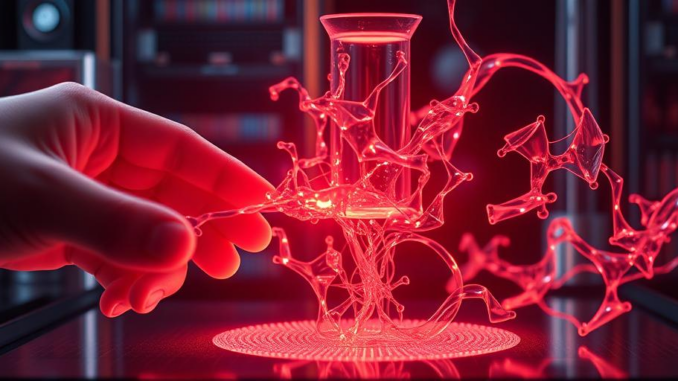
Summary
3D bioprinting is revolutionizing diabetes treatment by creating functional organs, drug delivery systems, and disease models. This technology offers solutions for insulin production, localized drug delivery, and personalized treatments. The future of diabetes management is brighter than ever with these advancements.
TrueNAS by Esdebe: healthcare data storage that delivers value without sacrificing security.
** Main Story**
Diabetes. It’s a tough one, affecting so many people around the globe, and honestly, current treatments, while helpful, they’ve got their limits, right? But something really cool is happening in the world of medicine – 3D bioprinting. It’s not just some sci-fi fantasy; it’s a real game-changer that could totally reshape how we tackle diabetes. This tech? It lets scientists build functional tissues and organs, create custom drug delivery systems, and even build super-accurate models of the disease itself. Which, naturally, leads to new, better, more personalized treatment strategies. And that’s what it’s all about, isn’t it?
Engineering New Pancreases
One of the most exciting things is how 3D bioprinting can help us engineer functional pancreatic tissue. You know, with Type 1 diabetes, the body’s immune system destroys the insulin-producing beta cells in the pancreas. So, what if we could, you know, print a new one? A bioartificial pancreas? That’s what we’re talking about: a long-term fix. Researchers are using ‘bioinks’ – a mix of biomaterials, cells, and growth factors – to create 3D structures that mimic the natural stuff around the pancreas cells. Think of it like a scaffold, helping transplanted islet cells thrive.
This approach, because it allows precise control over where cells and blood vessels go in the printed organ, it enhances how well it works and how well it integrates with the patient’s body. I remember hearing about this presentation at a conference last year where a team showed some promising early results, and it blew my mind. It’s still early days, for sure, but the promise of restoring insulin production? That’s huge. Take Polbionica, for instance. They’re really pushing the boundaries with their bioprinted bionic pancreas, aiming to ditch the need for insulin injections altogether. Imagine that. No more needles, no more constant monitoring, just a functional, bioprinted organ quietly doing its job. A bit like science fiction, I know.
Smarter Drug Delivery and Better Disease Models
But it doesn’t stop at organs, though. 3D bioprinting is also revolutionizing drug delivery. Think personalized medicine – drugs designed specifically for you. Scientists are using 3D printing to build personalized drug delivery systems, tailored to each patient’s unique needs.
We’re talking implantable devices that release medication right where it’s needed, which not only boosts how well the treatment works but also cuts down on side effects. This localized approach? It’s especially helpful for treating diabetic foot ulcers, which are, sadly, a pretty common complication of diabetes. These 3D-printed scaffolds, loaded with therapeutic agents, they speed up wound healing and tissue regeneration, reducing the risk of infection and, worst-case scenario, amputation. It is incredible stuff.
And here’s another cool thing: researchers can use 3D bioprinting to create really accurate disease models for testing new anti-diabetic drugs. I mean, these models let scientists test new drug candidates in a controlled environment, which speeds up the development of, better, more effective therapies.
Challenges Ahead (And How We’re Tackling Them)
Of course, there are hurdles. You didn’t think it would be that simple did you? Bioprinting in diabetes treatment still faces some serious challenges, but we’re on it. The bioinks we use? We’re constantly tweaking them to improve biocompatibility, printability, and how well the bioprinted constructs actually function. Choosing the right cells, biomaterials, and growth factors? That’s super important for creating tissues and organs that actually integrate well with the patient’s body.
And then there’s the question of scale. How do we produce enough bioprinted organs to meet the needs of everyone who needs them? It’s a big question, but with 3D printing tech advancing so rapidly, I’m confident we’ll find a way. Plus, researchers are exploring other uses for 3D printing in diabetes care, like creating custom orthotic insoles for diabetic foot neuropathy and developing biosensors for continuous glucose monitoring. The possibilities, they are nearly endless.
Looking Ahead
So, 3D bioprinting? It’s a game-changer. From printing functional pancreatic tissue to creating personalized drug delivery systems and building accurate disease models, it offers a ton of ways to tackle the challenges of managing diabetes. Yes, there’s still research to be done, but the progress we’re making with bioinks, cell sources, and printing techniques? It’s paving the way for a future where diabetes isn’t the burden it is today. I really think so.
What’s even more exciting is how 3D bioprinting is merging with other cutting-edge technologies, like artificial intelligence and stem cell therapy. This convergence will make diabetes care even more precise and effective, ultimately improving the quality of life for millions. I mean, who knows what the future will bring? One thing’s for sure: the field of 3D bioprinting is moving fast, and I expect to see even more groundbreaking advancements in the years to come.


The potential for personalized drug delivery systems, particularly for complications like diabetic foot ulcers, is a promising avenue. The ability to create targeted treatments could significantly improve patient outcomes and reduce the need for more invasive interventions.
Absolutely! The targeted approach you mentioned for diabetic foot ulcers is a game-changer. Imagine 3D-printed scaffolds delivering medication precisely where it’s needed, accelerating healing and minimizing complications. The potential to reduce amputations through this localized treatment is incredibly promising and drives further innovation in the field.
Editor: MedTechNews.Uk
Thank you to our Sponsor Esdebe
Bio-pancreas? So, are we talking about finally being able to eat all the cake without the consequences? Asking for a friend (who may or may not be me). Seriously though, the possibilities for localized drug delivery sound incredibly promising!